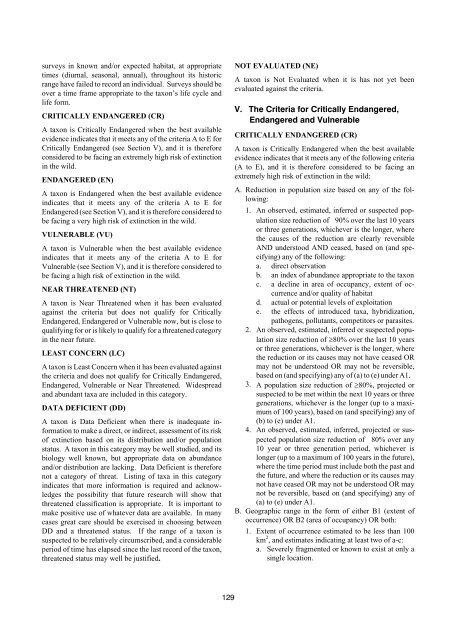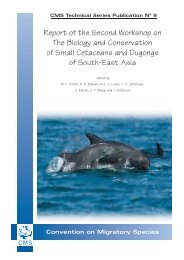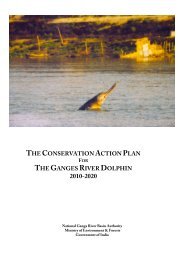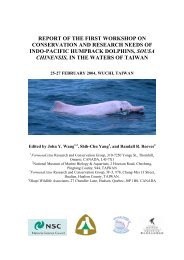Dolphins, Whales and Porpoises: 2002-2010 Conservation - IUCN
Dolphins, Whales and Porpoises: 2002-2010 Conservation - IUCN
Dolphins, Whales and Porpoises: 2002-2010 Conservation - IUCN
You also want an ePaper? Increase the reach of your titles
YUMPU automatically turns print PDFs into web optimized ePapers that Google loves.
surveys in known <strong>and</strong>/or expected habitat, at appropriate<br />
times (diurnal, seasonal, annual), throughout its historic<br />
range have failed to record an individual. Surveys should be<br />
over a time frame appropriate to the taxon’s life cycle <strong>and</strong><br />
life form.<br />
CRITICALLY ENDANGERED (CR)<br />
A taxon is Critically Endangered when the best available<br />
evidence indicates that it meets any of the criteria A to E for<br />
Critically Endangered (see Section V), <strong>and</strong> it is therefore<br />
considered to be facing an extremely high risk of extinction<br />
in the wild.<br />
ENDANGERED (EN)<br />
A taxon is Endangered when the best available evidence<br />
indicates that it meets any of the criteria A to E for<br />
Endangered (see Section V), <strong>and</strong> it is therefore considered to<br />
be facing a very high risk of extinction in the wild.<br />
VULNERABLE (VU)<br />
A taxon is Vulnerable when the best available evidence<br />
indicates that it meets any of the criteria A to E for<br />
Vulnerable (see Section V), <strong>and</strong> it is therefore considered to<br />
be facing a high risk of extinction in the wild.<br />
NEAR THREATENED (NT)<br />
A taxon is Near Threatened when it has been evaluated<br />
against the criteria but does not qualify for Critically<br />
Endangered, Endangered or Vulnerable now, but is close to<br />
qualifying for or is likely to qualify for a threatened category<br />
in the near future.<br />
LEAST CONCERN (LC)<br />
A taxon is Least Concern when it has been evaluated against<br />
the criteria <strong>and</strong> does not qualify for Critically Endangered,<br />
Endangered, Vulnerable or Near Threatened. Widespread<br />
<strong>and</strong> abundant taxa are included in this category.<br />
DATA DEFICIENT (DD)<br />
A taxon is Data Deficient when there is inadequate information<br />
to make a direct, or indirect, assessment of its risk<br />
of extinction based on its distribution <strong>and</strong>/or population<br />
status. A taxon in this category may be well studied, <strong>and</strong> its<br />
biology well known, but appropriate data on abundance<br />
<strong>and</strong>/or distribution are lacking. Data Deficient is therefore<br />
not a category of threat. Listing of taxa in this category<br />
indicates that more information is required <strong>and</strong> acknowledges<br />
the possibility that future research will show that<br />
threatened classification is appropriate. It is important to<br />
make positive use of whatever data are available. In many<br />
cases great care should be exercised in choosing between<br />
DD <strong>and</strong> a threatened status. If the range of a taxon is<br />
suspected to be relatively circumscribed, <strong>and</strong> a considerable<br />
period of time has elapsed since the last record of the taxon,<br />
threatened status may well be justified.<br />
NOT EVALUATED (NE)<br />
A taxon is Not Evaluated when it is has not yet been<br />
evaluated against the criteria.<br />
V. The Criteria for Critically Endangered,<br />
Endangered <strong>and</strong> Vulnerable<br />
CRITICALLY ENDANGERED (CR)<br />
A taxon is Critically Endangered when the best available<br />
evidence indicates that it meets any of the following criteria<br />
(A to E), <strong>and</strong> it is therefore considered to be facing an<br />
extremely high risk of extinction in the wild:<br />
A. Reduction in population size based on any of the following:<br />
1. An observed, estimated, inferred or suspected population<br />
size reduction of 90% over the last 10 years<br />
or three generations, whichever is the longer, where<br />
the causes of the reduction are clearly reversible<br />
AND understood AND ceased, based on (<strong>and</strong> specifying)<br />
any of the following:<br />
a. direct observation<br />
b. an index of abundance appropriate to the taxon<br />
c. a decline in area of occupancy, extent of occurrence<br />
<strong>and</strong>/or quality of habitat<br />
d. actual or potential levels of exploitation<br />
e. the effects of introduced taxa, hybridization,<br />
pathogens, pollutants, competitors or parasites.<br />
2. An observed, estimated, inferred or suspected population<br />
size reduction of 80% over the last 10 years<br />
or three generations, whichever is the longer, where<br />
the reduction or its causes may not have ceased OR<br />
may not be understood OR may not be reversible,<br />
based on (<strong>and</strong> specifying) any of (a) to (e) under A1.<br />
3. A population size reduction of 80%, projected or<br />
suspected to be met within the next 10 years or three<br />
generations, whichever is the longer (up to a maximum<br />
of 100 years), based on (<strong>and</strong> specifying) any of<br />
(b) to (e) under A1.<br />
4. An observed, estimated, inferred, projected or suspected<br />
population size reduction of 80% over any<br />
10 year or three generation period, whichever is<br />
longer (up to a maximum of 100 years in the future),<br />
where the time period must include both the past <strong>and</strong><br />
the future, <strong>and</strong> where the reduction or its causes may<br />
not have ceased OR may not be understood OR may<br />
not be reversible, based on (<strong>and</strong> specifying) any of<br />
(a) to (e) under A1.<br />
B. Geographic range in the form of either B1 (extent of<br />
occurrence) OR B2 (area of occupancy) OR both:<br />
1. Extent of occurrence estimated to be less than 100<br />
km 2 , <strong>and</strong> estimates indicating at least two of a-c:<br />
a. Severely fragmented or known to exist at only a<br />
single location.<br />
129





